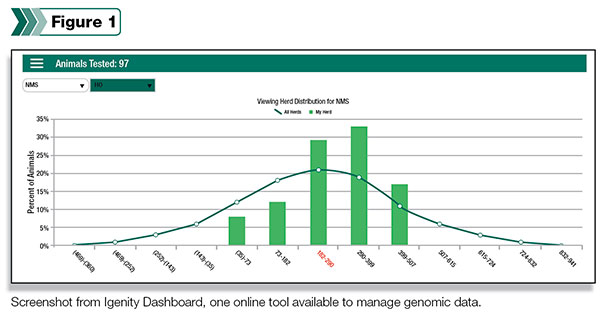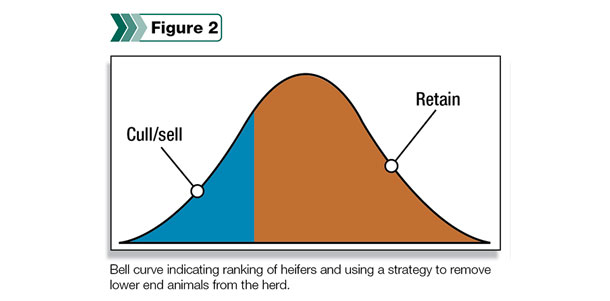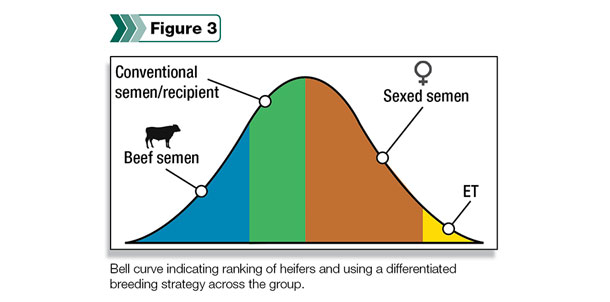Today, dairy farmers have access to a plethora of data about their cattle. Important information can be gleaned from data management systems, DHI records, pedigree information and genomic evaluations.
Now, with genomics, a dairy producer can receive values on more than 50 traits including data about production, fertility and health, plus genetic conditions on a calf as young as 15 days old.
Less than 10 years ago, it would have been unimaginable to have all of this available on such a young animal. Despite all of the data available, the saying “drowning in data but starving for information” can often ring true.
With so much data available, it is important to have access to tools to help manage the data and create information. By definition, data are simply facts or figures, or numbers that have no way of speaking for themselves.
When data are processed, interpreted, organized or presented in a meaningful or useful way, they become information. Finally, information can become knowledge and, if used correctly, can be used to make informed decisions based on genomic information and implemented on dairy operations.
Tools for data management
There are many tools available to manage genomic data, such as Excel-based reports, integration with on-farm data management software and other online tools. By using these tools or combination of tools, genomic data can be organized to provide meaning to the information.
Data can be sorted, filtered and indexed to provide relative rankings for the available population based on user-defined criteria.
Electronic spreadsheets are one way to organize genomic data, and many genomic companies will send information in this format. These types of reports contain multiple tabs that display the traits by categories.
Commonly included categories are key traits (where the most important traits can be viewed together), yield traits, fertility traits, type traits and genetic conditions. In addition, parentage information may also be included in these reports.
The advantage of these reports is: They are in a commonly utilized format and can be viewed offline; however, they have limited ability to offer benchmarks and other comparisons to provide a reference point to that data.
One feature usually available is the option of a percentile ranking for Net Merit ($) based on all other cattle in the U.S. This provides useful information by putting the data into perspective. For example, a cow with a Net Merit value of 262 would be in the 90th percentile, meaning it is better than 90 percent of the cows genomically tested in the U.S.
Another way to manage genomic data is through a producer’s data management system. Genomic results can be uploaded into the system and viewed alongside other animal records such as production data or adverse health events. The advantage of this system is having all data contained in one location for ease of daily use.
In addition, online programs exist to help manage genomic data. These tools make it easier to understand and visualize genomic information than ever before. Now, from anywhere with an Internet connection, genomic results can be sorted, filtered and visualized graphically.
These programs can make it easy to put genomic data in perspective by comparing it to a larger population that can be viewed graphically and in the form of a percentile as reference.
Programs are available that allow for the creation of custom reports that can be saved and retrieved at any time. These custom reports allow producers to customize traits viewed so they can create reports with only the traits most important to their profitability.
Additionally, these programs can make it easy for collaborators and other consultants to log on and help consult on genomic data – providing a greater access to information (Figure 1).
Creating a genomic protocol
Finally, now that data has been turned into information, it is time to use that information to make the most informed decisions on the dairy operation. Several strategies exist for applying genomic data. However, arguably the most important piece is creating a well-informed plan and sticking to it.
There are key questions to consider when creating a genomic protocol:
- How will you sort and rank your cattle? What traits are most important for profitability on your operation?
- What selection decisions will you make once the animals are ranked? Will you choose to use differential mating strategies to maximize your genetic gain?
- How will you implement this plan at your facility?
Once a plan is in place for sorting and ranking your cattle, you must determine how you will use the genomic data.
The first strategy is applicable for those who have excess heifers. It may be a situation where too many heifers are available, but it is unclear which ones to keep and which ones should be sold.
It would be a shame to know you sold some of your best heifers. By retaining the best genetics in your herd and marketing the lower-end genetics for other purposes, you can increase the rate of genetic progress in your herd (Figure 2).

A second strategy is to use genomics to make decisions at breeding time. By using a differentiated breeding strategy, you can increase genetics at a faster rate (Figure 3).

This strategy can be employed by ranking the heifers by your defined criteria and then selecting the very best for embryo transfer. The next group of high-end females can be bred with sexed semen to produce the next generation of heifers.
Then, use beef semen on the bottom end to obtain a premium on those calves and breed the remaining animals with conventional semen or use them as recipients for embryo transfer.
Finally, even the best laid plans will fail without proper implementation. Make sure you have a plan in place to implement your selection decisions on the farm. PD
Stewart Bauck is a veterinarian and the manager of GeneSeek, the genomics division of Neogen Corporation. Email Stewart Bauck.






